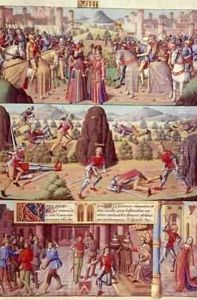Francois (Fouquet) Maitre Paintings
François Fouquet, also known as Maître François, was a French painter born around 1420. His exact birthplace is not documented, but he was active during the 15th century, a period known for the Northern Renaissance which saw significant developments in art, particularly in France, the Netherlands, and Germany.
Maître François was not as widely recognized as some of his contemporaries, such as the brothers Hubert and Jan van Eyck or Rogier van der Weyden, and as a result, details about his life and works are scarce. However, it is known that he contributed to the evolution of French painting by incorporating the realistic detail and complex iconography that were hallmarks of the Northern Renaissance.
His works are characterized by the use of rich colors, meticulous attention to detail, and a strong sense of realism. He was adept at oil painting, a technique that was gaining popularity at the time due to its versatile properties, allowing for gradual drying and a wide range of textural effects. Maître François's paintings often featured religious themes, which was typical for the era, with an emphasis on Christian iconography and narratives.
One of the challenges in studying artists like Maître François is the lack of surviving artworks that can be definitively attributed to them. Many works from this period have been lost, damaged, or were left unsigned, making it difficult for art historians to construct a comprehensive picture of their oeuvre and influence.
François Fouquet should not be confused with the later Jean Fouquet, who was also a French painter and is more widely recognized. Jean Fouquet, born around 1420 and died in 1481, was a preeminent French artist of the 15th century, known for his sophisticated and innovative approach to painting and manuscript illumination. His works were characterized by a combination of French Gothic and Italian Renaissance styles.
Despite the scarcity of information, Maître François is still an important figure in the history of French art. His contributions, however limited they may appear in the historical record, were part of the broader tapestry of Renaissance art that laid the groundwork for subsequent developments in European painting. Art historians continue to study the period in which he worked to better understand the contributions of lesser-known artists like him.
François Fouquet's death is not well documented, but he is believed to have died around 1481. The lack of records is not unusual for artists of the time, especially for those who did not achieve widespread fame or hold prominent positions at court or within the church. Despite this, the work of Maître François and his contemporaries has left a lasting legacy on the art world, influencing generations of artists who followed.
